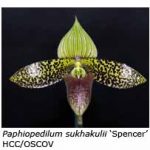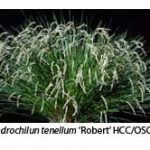Spring is my busiest time of the year, not just because it is the main show season but also because it’s the time when I re-pot most of my orchids. With few exceptions I re-pot every two or three years, so by the time I complete the cycle I really feel that I’ve gone ‘potty’!
Why do I re-pot so frequently? I may do so because an orchid has outgrown its container but that’s not the main reason. With few exceptions, most potting mixes have deteriorated to some extent within three years. In fact, many begin to decay within a year. Pine bark gradually becomes acidic, as well as ‘breaking down’ into finer material that tends to clog the mix so that it drains less freely. The other popular potting medium, Sphagnum moss, also drains less freely as it ages, and needs to be renewed frequently. It seems to last a little longer if it is mixed with crumbled polystyrene foam, possibly because this mix does not retain as much water as moss alone.
Orchids are best re-potted when they begin new growth and their new roots appear. If potting is delayed, the tender new root tips are easily broken, either when removing the old potting mix or when adding new. September is too early to re-pot most orchids in the shade house, so I confine my attention at that time to those in my heated glasshouse. Usually I begin with the paphiopedilums, using a potting mix of seedling-grade pine bark and Canunda shells. The latter help to counteract the development of acidity and also provide a source of calcium for these lime-loving plants. Paphiopedilums are particularly prone to root rot, and it is important to check the condition of their roots regularly and to re-pot if there is any sign of deterioration. Their roots are quick to rot but slow to regenerate. Never use a pot any larger than necessary to accommodate their roots.
There are too many different orchid genera in my glass house to list them all but in general they fall into two categories – those that I re-pot in pine bark, with or without a little added moss, and those that I re-pot in Sphagnum moss containing about 25% polystyrene foam. Cattleyas and oncidiums are re-potted in ‘straight’ pine bark while coelogynes and my larger dendrochilums are potted in bark containing a little moss, as this helps to retain moisture. Miltoniopsis hybrids, the smaller dendrochilums, masdevallias, draculas, dryadellas and other pleurothallids are usually potted in a moss/foam mix, although I generally use a bark/moss mix for those in larger pots (100 mm diameter or larger).
In October, as soon as I’ve cut their flower spikes, I begin re-potting my cymbidiums. I usually divide those that have filled their 300 mm-diameter pots, as I find cymbidiums too difficult to manage in larger pots (which are difficult to fit into the car to take to a show anyway!). I use 5-10 mm pine bark as potting mix and sprinkle some slow release fertiliser (Scott’s Osmocote®) on top of the mix at that time.
In November I begin re-potting my Australian native dendrobiums. In this case I prefer to use squat pots in conjunction with an 80:20 mix of 5-10 mm pine bark and river pebbles of similar size. Again, I shake a little slow-release fertiliser into the mix when I’ve finished. In late November, when my sarcochilus species and hybrids have finished flowering, I re-pot them in a 60:40 mix of pine bark and river pebbles, preferably each about 10 mm in diameter. Generally, I wait about three years before re-potting sarcochilus but acknowledge that they would benefit by being re-potted every second year, perhaps even annually. I always write the date of re-potting {e.g. 10/04, 11/04) on the back of the plant’s label, otherwise I would never remember when the orchid was last re-potted.



